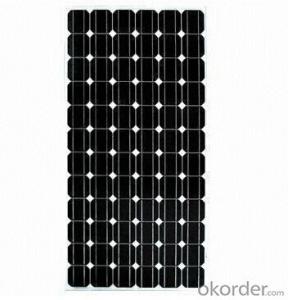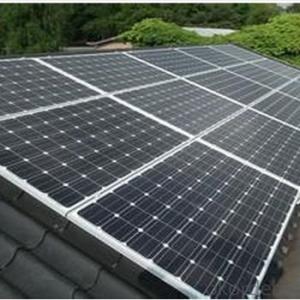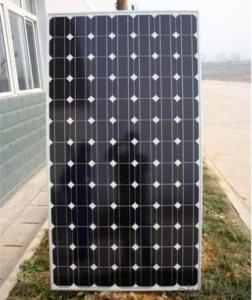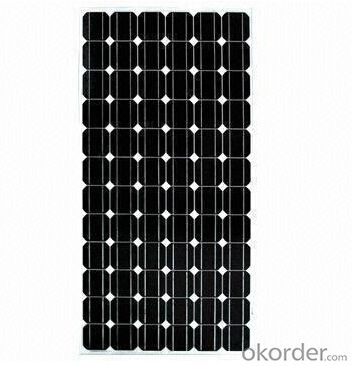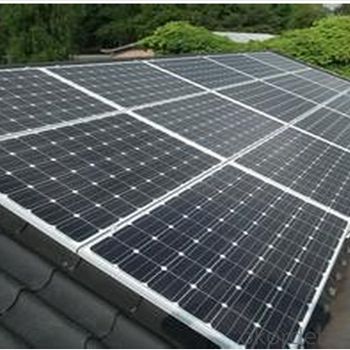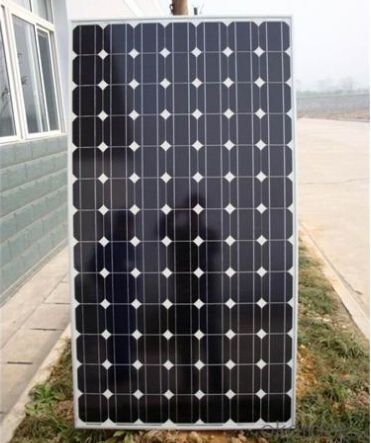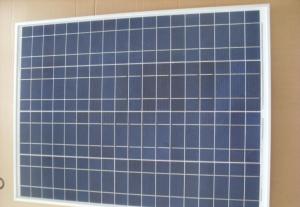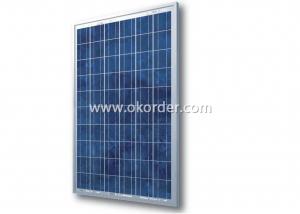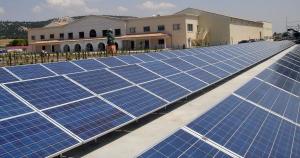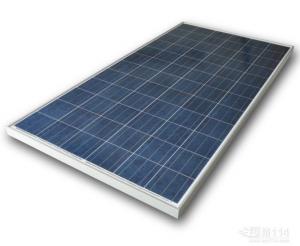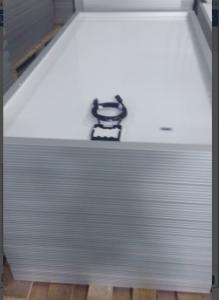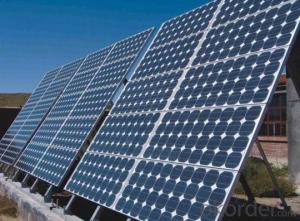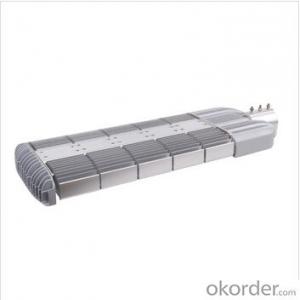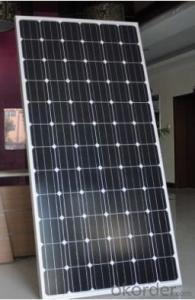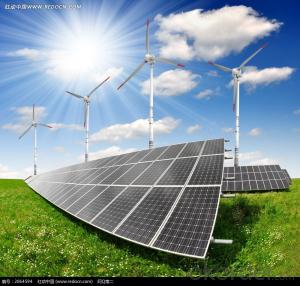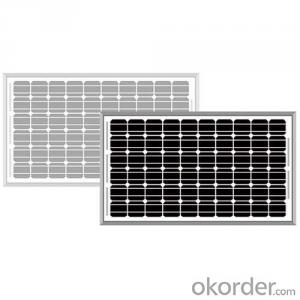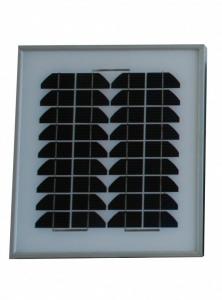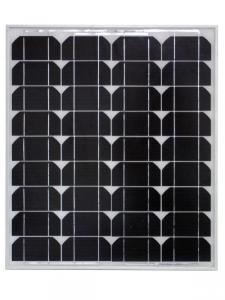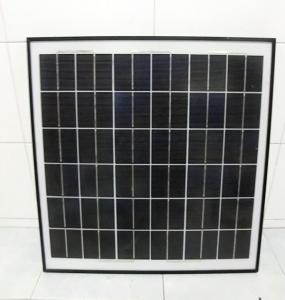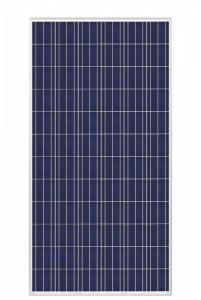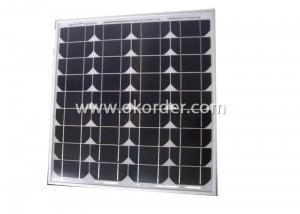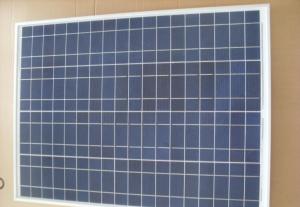Wyoming Solar Panels - Solar Monocrystalline Series Panels 300W
- Loading Port:
- Shanghai
- Payment Terms:
- TT OR LC
- Min Order Qty:
- 100 pc
- Supply Capability:
- 30000 pc/month
OKorder Service Pledge
OKorder Financial Service
You Might Also Like
Structure of Monocrystalline Solar Module for 300W Series Description:
Monocrystalline Solar Module for 300W l : High efficiency crystalline solar cell. Even if under the weak light, the solar module can produce maximum power output.
II Tempered glass (toughened glass): Anti-reflecting coating and high transmission rate glass increase the power output and mechanical strength of solar module.
III EVA and TPT: Using high quality EVA and TPT to prevent destroying and water.
IV AI frame: Without screw, rner connection. 6 holes on the frame can be installed easily.
V Junction box: Multi function junction box with water proof.
VI Long lifetime: ≥25 years; Less power decrease.
VII Good performance of preventing from atrocious weather such as wind and hails.
VIII Resisting moisture and etching effectively, not effected by geology.
IX The certificate issued by international authority: UL, TUV, IEC, CE.
Standard Test Conditions of Monocrystalline Silicon Solar Panel:
The opto-electrical specifications shown below are stabilized values being measured at Standard Test Conditions, Irradiance: 1000W/m2, Spectrum: AM1.5 at 25°C, The info below is subject to manufacturing tolerances. Where appropriate minutes of measurement are available and are used for the dimensioning of the installation.
Advantages of Monocrystalline Silicon Solar Panel
• CNBM Solar performance guarantees for 25 years
• 12 years guarantee for workmanship
• Timeliness of delivery
• Quality Products certified (TÜV, UL, CE, ISO)
Monocrystalline Silicon Solar Panel
Our designing philosophy is making solar product easy to use and convenient to maintain. We adhere to "develop inverter and controller" as our core technology, and built up solar product from 0.5W to 100KW into standard and mass production, meeting most customers' needs in this field.
| Parameter Type | Max Power (W) | Dimension(mm) | Weight | Max Current (A) | Max Voltage (V) | Short Circuit | Open Circuit |
| Current(A) | Voltage(V) | ||||||
| ESC 300W/36M | 300 | 1960*986*50 | 23.5 | 8.33 | 36 | 9.33 | 43.2 |
| ESC 295W/36M | 295 | 1960*986*50 | 23.5 | 8.19 | 36 | 9.18 | 43.2 |
| ESC 290W/36M | 290 | 1960*986*50 | 23.5 | 8.06 | 36 | 9.02 | 43.2 |
| ESC 285W/36M | 285 | 1960*986*50 | 23.5 | 7.92 | 36 | 8.87 | 43.2 |
| ESC 280W/36M | 280 | 1960*986*50 | 23.5 | 7.78 | 36 | 8.71 | 43.2 |
| ESC 275W/36M | 275 | 1960*986*50 | 23.5 | 7.64 | 36 | 8.56 | 43.2 |
| ESC 270W/36M | 270 | 1960*986*50 | 23.5 | 7.50 | 36 | 8.40 | 43.2 |
| ESC 265W/36M | 265 | 1960*986*50 | 23.5 | 7.36 | 36 | 8.24 | 43.2 |
| ESC 260W/36M | 260 | 1960*986*50 | 23.5 | 7.22 | 36 | 8.09 | 43.2 |
| ESC 255W/36M | 255 | 1960*986*50 | 23.5 | 7.08 | 36 | 7.93 | 43.2 |
| ESC 250W/36M | 250 | 1960*986*50 | 23.5 | 6.94 | 36 | 7.78 | 43.2 |
| ESC 240W/48M | 240 | 1580*1066*50 | 20.0 | 5.00 | 48 | 5.60 | 56.6 |
| ESC 230W/48M | 230 | 1580*1066*50 | 20.0 | 4.79 | 48 | 5.37 | 56.6 |
| ESC 230W/30M | 230 | 1640*986*50 | 19.0 | 7.67 | 30 | 8.59 | 36.0 |
| ESC 225W/30M | 225 | 1640*986*50 | 19.0 | 7.50 | 30 | 8.40 | 36.0 |
| ESC 220W/48M | 220 | 1580*1066*50 | 20.0 | 4.58 | 48 | 5.13 | 56.6 |
| ESC 220W/30M | 220 | 1640*986*50 | 19.0 | 7.33 | 30 | 8.21 | 36.0 |
| ESC 215W/30M | 215 | 1640*986*50 | 19.0 | 7.17 | 30 | 8.03 | 36.0 |
| ESC 210W/48M | 210 | 1580*1066*50 | 20.0 | 4.38 | 48 | 4.90 | 56.6 |
| ESC 210W/30M | 210 | 1640*986*50 | 19.0 | 7.00 | 30 | 7.84 | 36.0 |
| ESC 210W/27M | 210 | 1480*986*45 | 18.0 | 7.78 | 27 | 8.71 | 32.4 |
| ESC 205W/27M | 205 | 1480*986*45 | 18.0 | 7.59 | 27 | 8.50 | 32.4 |
| ESC 200W/27M | 200 | 1480*986*45 | 18.0 | 7.41 | 27 | 8.30 | 32.4 |
| ESC 200W/48M | 200 | 1580*1066*50 | 19.5 | 4.18 | 47.8 | 4.78 | 54.62 |
| ESC 195W/27M | 195 | 1480*986*45 | 18.0 | 7.22 | 27 | 8.09 | 32.4 |
| ESC 190W/27M | 190 | 1480*986*45 | 18.0 | 7.04 | 27 | 7.88 | 32.4 |
| ESC 185W/27M | 185 | 1480*986*45 | 18.0 | 6.85 | 27 | 7.67 | 32.4 |
| ESC 185W/36M | 185 | 1580*808*45 | 16.0 | 5.14 | 36 | 5.76 | 43.2 |
| ESC 180W/36M | 180 | 1580*808*45 | 16.0 | 5.00 | 36 | 5.60 | 43.2 |
| ESC 175W/36M | 175 | 1580*808*45 | 16.0 | 4.86 | 36 | 5.44 | 43.2 |
| ESC 170W/36M | 170 | 1580*808*45 | 16.0 | 4.72 | 36 | 5.29 | 43.2 |
| ESC 165W/36M | 165 | 1580*808*45 | 16.0 | 4.58 | 36 | 5.13 | 43.2 |
| ESC 160W/36M | 160 | 1580*808*45 | 16.0 | 4.44 | 36 | 4.98 | 43.2 |
| ESC 135W/27M | 135 | 1196*808*35 | 13.0 | 5.00 | 27 | 5.60 | 32.4 |
| ESC 130W/27M | 130 | 1196*808*35 | 13.0 | 4.81 | 27 | 5.39 | 32.4 |
| ESC 125W/27M | 125 | 1196*808*35 | 13.0 | 4.63 | 27 | 5.19 | 32.4 |
| ESC 120W/27M | 120 | 1196*808*35 | 13.0 | 4.44 | 27 | 4.98 | 32.4 |
| ESC 115W/27M | 115 | 1196*808*35 | 13.0 | 4.26 | 27 | 4.77 | 32.4 |
| ESC 110W/27M | 110 | 1200*808*35 | 12.7 | 4.08 | 27 | 4.74 | 31.39 |
| ESC 100W/18M | 100 | 1196*540*35 | 10 | 5.68 | 17.57 | 6.6 | 21.6 |
| ESC 95W/18M | 95 | 1196*540*35 | 10.0 | 5.28 | 18 | 5.91 | 21.6 |
| ESC 90W/18M | 90 | 1196*540*35 | 10.0 | 5.00 | 18 | 5.60 | 21.6 |
| ESC 85W/18M | 85 | 1196*540*35 | 10.0 | 4.72 | 18 | 5.29 | 21.6 |
| ESC 80W/18M | 80 | 1196*540*35 | 10.0 | 4.44 | 18 | 4.98 | 21.6 |
| ESC 75W/18M | 75 | 1196*540*35 | 10.0 | 4.17 | 18 | 4.67 | 21.6 |
| ESC 60W/18M | 60 | 810*540*30 | 7.0 | 3.33 | 18 | 3.73 | 21.6 |
| ESC 55W/18M | 55 | 810*540*30 | 7.0 | 3.06 | 18 | 3.42 | 21.6 |
| ESC 50W/18M | 50 | 810*540*30 | 7.0 | 2.78 | 18 | 3.11 | 21.6 |
| ESC 45W/18M | 45 | 620*540*35 | 5.0 | 2.50 | 18 | 2.80 | 21.6 |
| ESC 40W/18M | 40 | 610*540*30 | 5.0 | 2.22 | 18 | 2.49 | 21.6 |
| ESC 30W/18M | 30 | 440*540*30 | 3.5 | 1.67 | 18 | 1.87 | 21.6 |
| ESC 25W/18M | 25 | 440*540*30 | 3.5 | 1.39 | 18 | 1.56 | 21.6 |
| ESC 20W/18M | 20 | 430*430*30 | 3.0 | 1.11 | 18 | 1.24 | 21.6 |
| ESC 15W/18M | 15 | 285*450*30 | 2.0 | 0.83 | 18 | 0.93 | 21.6 |
| ESC 10W/18M | 10 | 285*341*30 | 1.5 | 0.56 | 18 | 0.62 | 21.6 |
FAQ
We have organized several common questions for our clients,may help you sincerely:
①What price for each watt?
It depends on the quantity, delivery date and payment terms,
②What is your size for each module? Can you tell me the Parameter of your module?
We have different series of panels in different output, both c-Si and a-Si. Please take the specification sheet for your reference.
③Can you provide the peripheral products of the solar panels, such as the battery, controller, and inverter? If so, can you tell me how do they match each other?
Yes, we can, we have two companies for solar region, one is CNBM International, the other is CNBM engineering Co.
We can provide you not only the solar module but also the off grid solar system, we can also provide you service with on grid plant.
④What is your warranty system?
Our product performance guarantees for 25 years
• 12 years guarantee for workmanship
• Timeliness of delivery
• Quality Products certified (TÜV, UL, CE, ISO)
⑤How do you pack your products?
We have rich experience on how to pack the panels to make sure the safety on shipment when it arrives at the destination.
⑥ Can you do OEM for us?
Yes, we can.
⑦How long can we receive the product after purchase?
In the purchase of product within three working days, We will arrange the factory delivery as soon as possible. The pecific time of receiving is related to the state and position of customers.Commonly 7 to 10 working days can be served.
- Q: How do solar panels affect the overall energy security of a building?
- Solar panels can greatly enhance the overall energy security of a building. By harnessing the sun's energy, solar panels provide a reliable and renewable source of electricity. This reduces dependence on traditional fossil fuels and the associated risks of price fluctuations, supply disruptions, and geopolitical tensions. With solar panels, buildings can generate their own clean energy, ensuring a more stable and self-sufficient power supply, which ultimately contributes to a stronger energy security profile.
- Q: How does the snow cover get removed from the panels?
- Green energy magically makes the snow transparent. The more I learn about solar and wind, particularly selling excess power back to the utility, the less sense it makes. You'll have noticed, perhaps, that there was no way to store the power from the panels for when it's really needed.
- Q: if car companies install solar panels on cars, like in all the car were the sun can reach that would reduce the consumption of gas in the summer, and might save some energy for winter and if that energy is not enough they can use gas or electricity i think that would be a lot of savings, and less contamination i don't know that is my idea what do you people think?
- Solar panels, a large storage batter, an electric motor all add weight. This reduces vehicle performance and almost means more energy is required just to move it. There are some solar cars that university engineering departments race. However these solar cars are very light weight, not practical automobiles. Typically they seat only one person and no cargo. Staff actually have to follow them in regular cars with parts and equipment in case of a malfunction or breakdown.
- Q: Can solar panels be installed on an agricultural greenhouse or nursery?
- Yes, solar panels can be installed on an agricultural greenhouse or nursery. In fact, it is a popular practice in many agricultural settings. Solar panels can provide renewable energy to power the greenhouse or nursery, reducing reliance on fossil fuels and lowering energy costs. Additionally, the panels can be mounted on the roof or ground around the facility, making efficient use of available space.
- Q: Can solar panels be installed on water treatment plants or utilities?
- Yes, solar panels can be installed on water treatment plants or utilities. In fact, many water treatment plants and utilities are increasingly adopting solar power as a sustainable and cost-effective energy solution. Solar panels can be installed on rooftops, open fields, or even on floating platforms over water bodies, providing clean energy to power the operations of these facilities.
- Q: Do solar panels require direct sunlight to generate electricity?
- Yes, solar panels do require direct sunlight to generate electricity. While they can still produce some electricity in indirect or diffused sunlight, their efficiency significantly decreases without direct sunlight. Direct sunlight provides the optimal conditions for solar panels to convert sunlight into electricity effectively.
- Q: Can solar panels be installed on historical buildings?
- Yes, solar panels can be installed on historical buildings. However, the installation process may require special considerations to maintain the historical integrity of the structure.
- Q: So I'm trying to figure out what to ask for my birthday because its one of the few times I can get stuff for no reason, like stuff I don't normally go to the store to buy. (i dont go to the store to get much at all anyway).Anyway, I'm interested in solar panels and led and electronics and i was wondering if there is anything not over expensive that would be cool. Some things I'm interested in:solar, wind, water energyGadgets (multitools, swiss army knives)Vibram fivefingersdrawingmaking stuff (duct tape wallets, stuff out of altoids containers)basically technology and outdoors-gear stuffoh and im 6 turnin 7 male.
- solar panel is expensive, but small solar panel is not expensive, for example, 5w solar panel, solar light also not expensive led light also not expensive. i am not sure about other stuff that you said
- Q: How are solar panels made?
- Solar panels are made using a multi-step process that involves the production of silicon wafers, the application of various layers and coatings, and the assembly of individual cells into a panel.
- Q: Are solar panels expensive?
- Solar panels can be initially expensive to purchase and install, but their long-term benefits outweigh the cost. The price of solar panels has significantly decreased over the years, and there are various financing options available to make them more affordable for homeowners and businesses. Additionally, solar panels can save money on energy bills and provide a return on investment through incentives, tax credits, and potential resale value.
Send your message to us
Wyoming Solar Panels - Solar Monocrystalline Series Panels 300W
- Loading Port:
- Shanghai
- Payment Terms:
- TT OR LC
- Min Order Qty:
- 100 pc
- Supply Capability:
- 30000 pc/month
OKorder Service Pledge
OKorder Financial Service
Similar products
Hot products
Hot Searches
Related keywords
